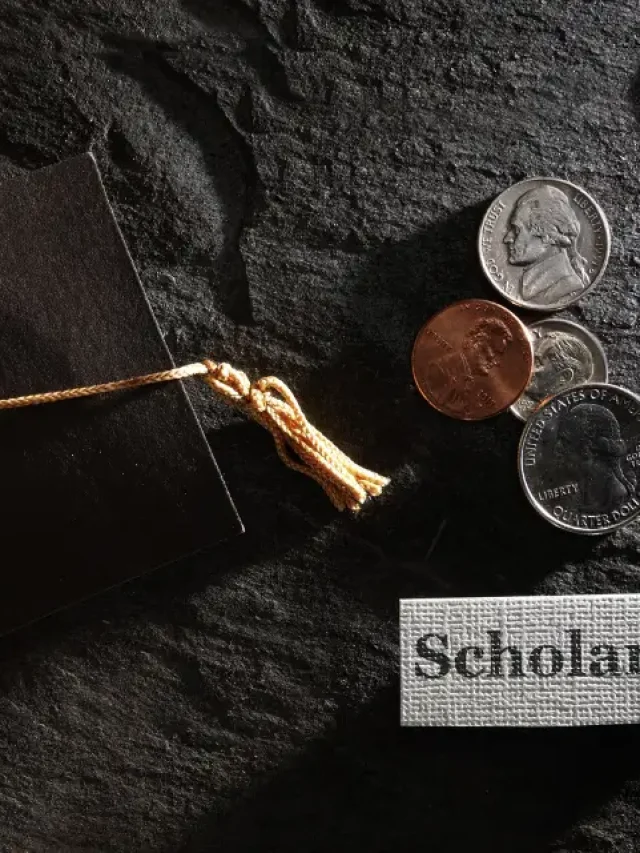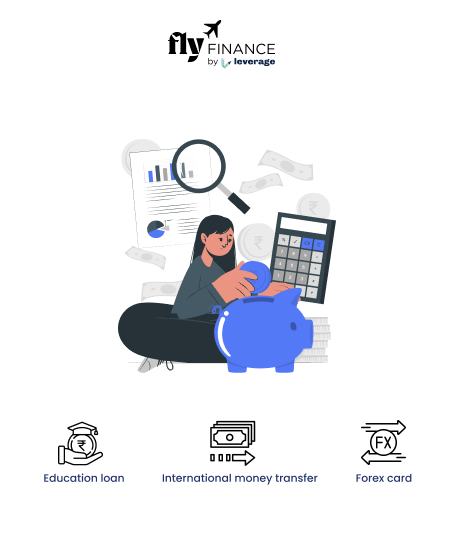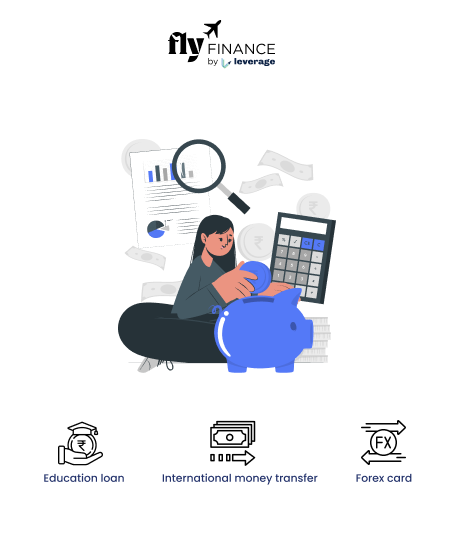Margin money in education loans refers to the portion of the total educational expenses that the borrower (student or guardian) must contribute from their own resources. When an aspiring student applies for an education loan to study abroad, they come across many financial terms like quantum of finance, repayment period, moratorium period and margin money.
Margin money in education loans is one of the most confusing financial jargon for many. The margin money can impact the eligibility of a student for an education loan. Most banks keep margin money rate between 10-25% on education loans availed. In this blog, we will help you understand all you need to know about margin money, in detail.
Table of contents
- What is Margin Money in Education Loans?
- How to Calculate Margin Money for Education Loans?
- Relationship between Margin Money and Education Loan Amount
- Is Margin Money Required for Education Loans Abroad?
- What is 0% Margin Money?
- Banks that Charge Margin Money
- How Margin Money Affects Education Loan Eligibility?
- Types of Margin Money in Education Loans
- Tips for Managing Margin Money in Education Loans Effectively
- FAQs on Margin Money on Education Loans
Also Read: Check out our blog on one of the most flexible alternatives to finance your study abroad dreams- gold loan for education: benefits, criteria, documents & process.
What is Margin Money in Education Loans?
Margin money is the percentage of money that the borrower is required to contribute towards an education loan on their own. To simple find Margin money, simply just find the total cost of education and multiply it by the margin percentage set by the bank.
Let us understand margin money in education loan with an example:
Ramesh goes to XYZ Bank to apply for an INR 50 lakh loan for his postgraduate studies in London. The bank states that it will sanction only INR 42.50 lakhs. This means that Ramesh will have to take care of INR 7.5 lakhs himself (which is 15% of the total loan amount*). Here, INR 7.5 lakhs or 15% is the Margin Money.
How to Calculate Margin Money for Education Loans?
Calculating margin money for an education loan is relatively straightforward. It is usually a percentage of the total educational expenses, including tuition fees, accommodation costs, books, and travel expenses.
*To calculate the percentage of margin money, the following formula is used-
{1- (Loan amount sanctioned) / Overall expense} x 100
Considering the above example for figures, here goes the calculation of the margin money percentage calculation-
[1- (42,50,000/ 50,00,000)] x 100
[1- 0.85] x 100
0.15 x 100
15%
Relationship between Margin Money and Education Loan Amount
There exists an inverse relationship between margin money and the education loan. This means that if an education loan is high, the margin money will be less and if a borrower lowers the education loan expenses, the margin money will be high. For example, the Margin money might be at 10% on INR 50 lakhs but 15% on INR 30 lakhs by the lenders.
Margin money plays a key role in education loans by ensuring that students are financially invested in their education. It acts as a safeguard for the lender, ensuring that the borrower has enough financial stability to contribute towards their educational expenses. Banks and lenders generally view this contribution as a commitment from the student to complete their studies successfully.
Is Margin Money Required for Education Loans Abroad?
Yes, margin money is typically required for education loans for studies abroad. While domestic loans might require a smaller margin (usually 10-15%), education loans for international studies require a larger margin. Lenders generally expect the student to contribute a margin of 15-25% of the total cost, which includes tuition fees, living expenses, and other educational costs.
This higher margin is due to the increased financial risk associated with lending for foreign education. Additionally, students are often expected to prove that they can arrange for this margin money from their own resources or from other financial sources such as family savings, scholarships, or part-time jobs.
What is 0% Margin Money?
0% loan margin means no margin money in education loans. In such cases, the financial institution provides 100% of the education loan as asked by the borrower. Borrowers are not required to make any contributions to the overall expenditure. Here’s a list of financial institutions that have no margin money in education loans-
Also Read: Know all about LLB education loans to study abroad and the best public banks, private banks, and NBFCs providing education loans for LLB students.
Banks that Charge Margin Money
Above mentioned are the names of NBFCs (non-banking financial institutions) that offer 0% margin money in education loans. However, this is not the case with public and private banks. They have a certain percentage margin money fixed that needs to be arranged by the borrowers. It is between 10-25% for different lenders on different loan amounts. Let’s have a look at the banks and the margin money charged by them-
| IDFC First Bank NIL (However, the bank may charge 0-10% based on the student’s profile | Private Banks Charging Margin Money in Education Loans |
| Union Bank of India Up to INR 4 lakhs- NIL Above INR 4 lakhs- 5% (studies in India), 15% (studies abroad) NRI students- 15% | ICICI Bank No margin for premier Institutes 15% margin for Other category Institutes (Margin can be FD/scholarship/initial fee paid to the institute) |
| State Bank Of India Up to INR 4 lakhs- NIL Above INR 4 lakhs- 5% (studies in India), 15% (studies abroad) Global Edvantage- 10% | IDFC First Bank NIL (However, bank may charge 0-10% based on the student’s profile |
| Canara Bank Up to INR 4 lakhs- NIL Above INR 4 lakhs- 5% (studies in India), 15% (studies abroad) | Axis Bank Up to INR 4 lakhs- NIL Above INR 4 lakhs- 5% (studies in India), 15% (studies abroad) |
| Bank of Baroda Up to INR 4 lakhs- NIL Above INR 4 lakhs- 5% (studies in India), 15% (studies abroad) | YES Bank 0-15% |
| Punjab National Bank Up to INR 4 lakhs- NIL Above INR 4 lakhs- 5% (studies in India), 15% (studies abroad) | HDFC Bank Up to INR 4 lakhs- NIL Above INR 4 lakhs- 5% (studies in India), 15% (studies abroad) |
How Margin Money Affects Education Loan Eligibility?
The requirement of margin money can affect a student’s eligibility for an education loan. Financial institutions often see margin money as a way to ensure that the borrower has a stake in their education, which may reduce the risk of default. The higher the margin money, the lower the loan amount needed, which can improve the chances of loan approval.
However, students who do not have sufficient funds for margin money may face difficulties in securing the full loan amount. Banks may provide a loan for only up to 90% of the total cost for domestic education, while the remaining 10% (or more) is expected to be covered by margin money. For overseas education loans, this margin can range from 15% to 25%, making it essential for students to understand these terms before applying.
Types of Margin Money in Education Loans
Margin money for education loans can be classified into two main types: direct and indirect margin money. By understanding these different types, students can plan more effectively for funding their education. Let us see the types of margin money in detail:
- Direct Margin Money: This is the amount that the borrower must pay from their own savings or resources before the loan is disbursed. This could include contributions from the student’s savings, family funds, or personal investments.
- Indirect Margin Money: In some cases, the margin may not need to be paid upfront. Instead, students may arrange the funds through other means, such as income from a part-time job, scholarships, or grants. This type of margin money may be flexible and adjusted over time.
Tips for Managing Margin Money in Education Loans Effectively
Managing margin money effectively is essential for minimizing financial stress while pursuing an education loan. Here are a few tips for students to manage margin money efficiently, by following these tips, students can reduce the impact of margin money and focus more on their studies without being overwhelmed by financial concerns:
- Start Planning Early: Begin saving for margin money well before applying for the loan. Consider setting aside a percentage of your savings or exploring investment options that can help you accumulate the necessary funds.
- Explore Scholarships and Grants: Look for scholarship opportunities that can cover part or all of your margin money. Many universities and external organizations offer financial assistance based on merit or need.
- Use Family Resources: If margin money is a significant challenge, consider using family savings or assets to meet the margin requirements. This could include borrowing from family members or using personal assets as collateral.
- Take Part-time Jobs: If studying abroad, students can earn money through part-time jobs to meet the margin money requirements. Many countries allow international students to work part-time, which can provide valuable financial relief.
FAQs on Margin Money on Education Loans
Margin money is the percentage of money that the borrower is required to contribute towards an education loan on their own. It is the difference between the total loan amount you require minus what the bank grants you.
The minimum loan margin is 10% and public-sector banks need to follow it. However, it is set between 10-25%.
Yes, many NBFCs like InCred, Prodigy Finance, Avanse, MPower Financing, and Auxilo provide education loans without margin.
0% loan margin means no margin money in education loans. In such cases, the financial institution provides 100% of the education loan as asked by the borrower. Borrowers are not required to make any specific contributions to the overall expenditure.
To calculate the percentage of margin money, the following formula is used-
{1- (Loan amount sanctioned) / Overall expense} x 100.
For many students, margin money can indeed feel like a financial burden, especially if they are already facing high tuition fees or living expenses. However, it is important to remember that margin money is a common practice designed to protect both the student and the lender.
No, margin money requirements tend to be higher for international education loans. While domestic education loans may require a 10-15% margin, international loans can require anywhere from 15% to 25%, depending on the total cost of education and the lender’s policies.
This was all about margin money in education loans and how it is calculated. Though many banks keep margin money and only provide up to 100% of funds to finance your higher studies abroad, but it is not compulsory. Borrowers who need 100% finance and are unable to make self-contribution towards education loans can choose education loans from NBFCs that offer 0% loan margin.
To know more about the education loan application process, the best bank accounts for students, forex and banking experience for global students or international money transfers, reach out to our experts at 1800572126 to help ease your study abroad experience.
| Related Blogs |
| Haryana Government Education Loan Scheme To Study Abroad |
| FAQs on Personal Loans for Debt Consolidation |
| FAQs on Education Loan Repayment |
Follow Us on Social Media





























